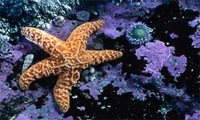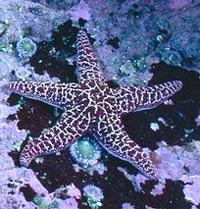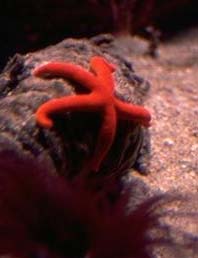
 Skeleton: Sea stars do not have movable skeletons, but instead possess a hydraulic water vascular system. The water vascular system has many projections called tube feet, located on the ventral face of the sea star's arms, which function in locomotion and aid with feeding. Skeleton: Sea stars do not have movable skeletons, but instead possess a hydraulic water vascular system. The water vascular system has many projections called tube feet, located on the ventral face of the sea star's arms, which function in locomotion and aid with feeding.
Name: As these creatures are echinoderms and not actually fish, most marine biologists prefer to replace the term starfish with the less misleading term sea star.
Distribution: There are about 1,800 living species of sea star, and they occur in all of the Earth's oceans. The greatest variety of sea stars is found in the northern Pacific Ocean. Asterias is a common genus found in European waters and on the eastern coast of the United States; Pisaster, along with Dermasterias ("leather star"), are usually found on the western coast.
 Habitat: Habitats could range from tropical coral reefs, kelp forests to deep-sea floor, although none of them live within the water column; all species of sea stars found are living as benthos. As echinoderms need a delicate internal balance in their body, no sea stars are found in freshwater environments, with exception of very few species of sea stars found in slightly estuarine habitats. Habitat: Habitats could range from tropical coral reefs, kelp forests to deep-sea floor, although none of them live within the water column; all species of sea stars found are living as benthos. As echinoderms need a delicate internal balance in their body, no sea stars are found in freshwater environments, with exception of very few species of sea stars found in slightly estuarine habitats.
 External anatomy: Sea stars are composed of a central disc from which arms sprout in radial symmetry. Most starfish have five arms, however some have more or less; in fact some starfish can have different numbers of arms even within one species. The mouth is located underneath the sea star on the oral or ventral surface, while the anus is located on the top of the animal. The spiny upper surface covering the species is called the aboral or dorsal surface. On the aboral surface there is a structure called the madreporite, which acts as a water filter and supplies the sea star's water vascular system with water to move. Additional parts like cribriform organs present exclusively in Porcellanasteridae are used to generate current in the burrows made by these infaunal sea stars. External anatomy: Sea stars are composed of a central disc from which arms sprout in radial symmetry. Most starfish have five arms, however some have more or less; in fact some starfish can have different numbers of arms even within one species. The mouth is located underneath the sea star on the oral or ventral surface, while the anus is located on the top of the animal. The spiny upper surface covering the species is called the aboral or dorsal surface. On the aboral surface there is a structure called the madreporite, which acts as a water filter and supplies the sea star's water vascular system with water to move. Additional parts like cribriform organs present exclusively in Porcellanasteridae are used to generate current in the burrows made by these infaunal sea stars.
Sea stars, while having their own basic body plan, radiate diversely in shapes and colors and the morphology differs between each species; for example, a species of sea star may have rows of spines on their arms as means of protection. Ranging from nearly pentagonal (example: Indo-pacific Cushion Star, Culcita novaeguineae) to gracile stars like those on Zoroaster genus.
Eye: Sea stars have a simple eye at the end of each arm. The eye is able to "see" only differences of light and dark, which is useful in detecting movement.
 Pedicellariae: On the surface of the sea star, surrounding the spines, are small white objects known as pedicellariae. There are large numbers of these pedicellariae on the external body which serve to prevent encrusting organisms from colonising the sea star. The radial canal which is across each arm of the sea star has tooth-like structures called ampullae, which surround the radial canal. The aboral surface is also covered with papulae that are involved with the sea star's respiratory system. Pedicellariae: On the surface of the sea star, surrounding the spines, are small white objects known as pedicellariae. There are large numbers of these pedicellariae on the external body which serve to prevent encrusting organisms from colonising the sea star. The radial canal which is across each arm of the sea star has tooth-like structures called ampullae, which surround the radial canal. The aboral surface is also covered with papulae that are involved with the sea star's respiratory system.
 Color: Sea stars are often brightly colored, usually from reddish hues to violet, and unusual colors such as green and blue exist in some species, but come in muted colors as well. Patterns including mosaic-like tiles formed by ossicles, stripes, interconnecting net between spines, pustules with bright colors, mottles or spots. These mainly serve as camouflage or warning coloration displayed by many other marine animals as means of protection against predation. Several types of toxins and secondary metabolites have been extracted from several species of sea stars and now being subjected into research worldwide for pharmacy or other uses such as pesticides. Color: Sea stars are often brightly colored, usually from reddish hues to violet, and unusual colors such as green and blue exist in some species, but come in muted colors as well. Patterns including mosaic-like tiles formed by ossicles, stripes, interconnecting net between spines, pustules with bright colors, mottles or spots. These mainly serve as camouflage or warning coloration displayed by many other marine animals as means of protection against predation. Several types of toxins and secondary metabolites have been extracted from several species of sea stars and now being subjected into research worldwide for pharmacy or other uses such as pesticides.

Diet: Most sea star species are generalist predators, some eating bivalves like mussels, clams, and oysters; or any animal slow enough to be unable to evade the attack (e.g. dying fish). Some species are detritivores, eating decomposed animal and plant material, or organic films attached to substrate. The others may consume coral polyps (the best-known example for this is the infamous Acanthaster planci), sponges or even suspended particles and planktons (sea stars from the Order Brisingida). The process of feeding or capture may or may not be aided by special parts; Pisaster brevispinus or Short-spined Pisaster from west coast of America may use a set of specialized tube feet capable of extending itself deep into the soft substrata, hauling out the prey (usually clams) from within.
Locomotion: Sea stars move using a water vascular system. Water comes into the system via the madreporite. It is then circulated from the stone canal to the ring canal and into the radial canals. The radial canals carry water to the ampullae and provide suction to the tube feet. The tube feet latch on to surfaces and move in a wave, with one body section attaching to the surfaces as another releases. Most sea stars cannot move quickly. However, some burrowing species like sea stars from genus Astropecten and Luidia are quite capable of rapid, creeping motion - it "glides" across the ocean floor. This motion results from their pointed tubefeet adapted specially for excavating local area of sand.
Regeneration: Some species of sea star have the ability to regenerate lost arms and can regrow an entire new arm in time. Most species must have the central part of the body intact to be able to regenerate, but a few can grow an entire starfish from a single ray. Included in this group are the Red and Blue Linkia Star. The regeneration of these stars is possible due to the vital organs kept in their arms. When this ability of the sea stars was unknown, to avoid proliferation, people used to cut them in two and throw them back in the sea, which actually used to provoke overpopulation.
Internal anatomy: The body cavity also contains the water vascular system that  operates the tube feet, and the hemal system. Hemal channels form rings around the mouth (the oral hemal ring), closer to the top of the starfish and around the digestive system (the gastric hemal ring). The axial sinus, a portion of the body cavity, connects the three rings. Each ray also has hemal channels running next to the gonads. operates the tube feet, and the hemal system. Hemal channels form rings around the mouth (the oral hemal ring), closer to the top of the starfish and around the digestive system (the gastric hemal ring). The axial sinus, a portion of the body cavity, connects the three rings. Each ray also has hemal channels running next to the gonads.
Digestion and excretion: Sea star digestion is carried out in two separate stomachs, the cardiac stomach and the pyloric stomach. The cardiac stomach, which is a sack like stomach located at the center of the body may be everted - pushed out of the organism's body and used to engulf and digest food. Some species take advantage of the great endurance of their water vascular systems to force open the shells of bivalve mollusks such as clams and mussels, and inject their stomachs into the shells. Once the stomach is inserted inside the shell it digests the mollusk in place.
Because of this ability to digest food outside of its body, the sea star is able to hunt prey that are much larger than its mouth would otherwise allow including arthropods, and even small fish in addition to mollusks.
Some echinoderms have been shown to live for several weeks without food under artificial conditions—it is believed that they may receive some nutrients from organic material dissolved in seawater.
Nervous system: Echinoderms have rather complex nervous systems, but lack a true centralized brain. All echinoderms have a nerve plexus (a network of interlacing nerves), which lies within as well as below the skin. The esophagus is also surrounded by a number of nerve rings, which send radial nerves that are often parallel with the branches of the water vascular system. The ring nerves and radial nerves coordinate the starfish's balance and directional systems. Although the echinoderms do not have many well-defined sensory inputs, they are sensitive to touch, light, temperature, orientation, and the status of water around them. The tube feet, spines, and pedicellariae found on starfish are sensitive to touch, while eyespots on the ends of the rays are light-sensitive.
 Circulation and respiration: Starfish are almost unique in the fact that, unlike most other animals, they do not have blood but instead use sea water to pump around their bodies. Circulation and respiration: Starfish are almost unique in the fact that, unlike most other animals, they do not have blood but instead use sea water to pump around their bodies.
The water vascular system uses cilia and the constantly contracting ampullae to keep things moving. An ionic imbalance causes water to flow into the madreporite, entering the water vascular system. Some of this water is diverted into the perivisceral coelom (the large cavity in which major organs are suspended), where it is circulated by the beating of cilia. Most oxygen enters the starfish via diffusion into the tube feet (with the water vascular system), or the papulae (small sacs covering the upper body surface).

Reproduce alone, or with a mate: Sea stars are capable of both sexual and asexual reproduction. Individual sea stars are male or female. Fertilization takes place externally, both male and female releasing their gametes into the environment. Resulting fertilised embryos form part of the zooplankton.
 Sea stars are developmentally (embryologically) known as deuterostomes. Their embryo initially develops bilateral symmetry, indicating that sea stars probably share a common ancestor with the chordates, which includes the fish. Later development takes a very different path however as the developing sea star settles out of the zooplankton and develops the characteristic radial symmetry. Some species reproduce cooperatively, using environmental signals to coordinate the timing of gamete release; in other species, one to one pairing is the norm. Sea stars are developmentally (embryologically) known as deuterostomes. Their embryo initially develops bilateral symmetry, indicating that sea stars probably share a common ancestor with the chordates, which includes the fish. Later development takes a very different path however as the developing sea star settles out of the zooplankton and develops the characteristic radial symmetry. Some species reproduce cooperatively, using environmental signals to coordinate the timing of gamete release; in other species, one to one pairing is the norm.
Some species of sea star also reproduce asexually by fission, often with part of an arm becoming detached and eventually developing into an independent individual sea star. This has led to some notoriety. Sea stars can be pests to fishermen who make their living on the capture of clams and other mollusks at sea as sea stars prey on these. The fishermen would presumably kill the sea stars by chopping them up and disposing of them at sea, ultimately leading to their increased numbers until the issue was better understood.
All text is available under the terms
of the GNU Free Documentation License
|